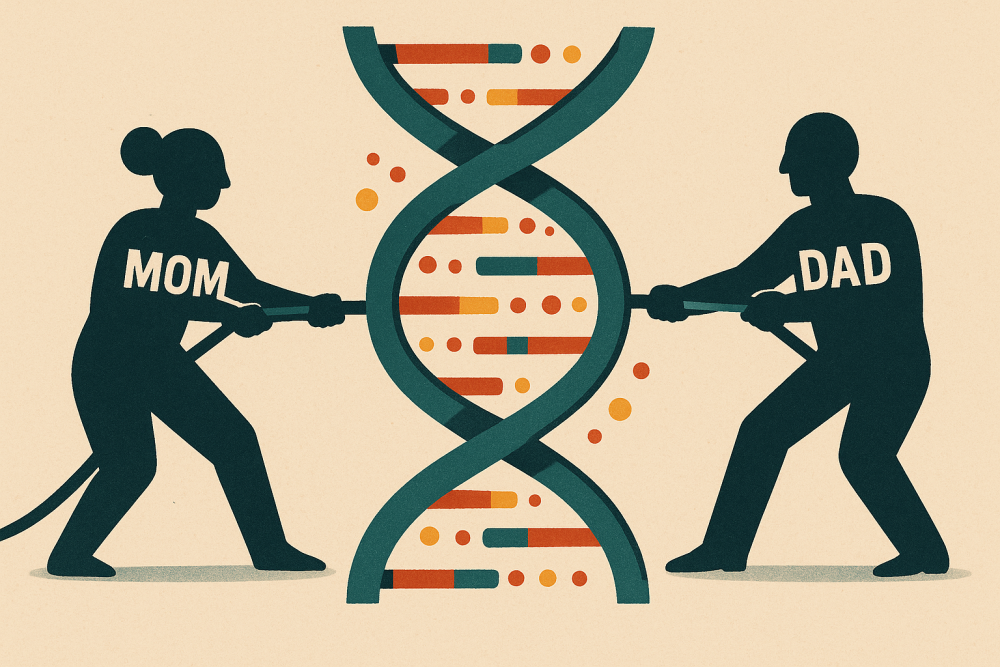The Tug of Genes — a Glimpse of Wonder entry™ (Part 4 of 9) —
The Tug of Genes
— a Glimpse of Wonder entry™ (Part 4 of 9) —
At first glance, it seems like the developing baby is quietly following instructions—just executing a prewritten plan. But look closer, and you’ll see something far more dynamic: a silent negotiation, a tug-of-war not between parent and child, but between the parents themselves—inside the child.
It’s called genomic imprinting, and it’s one of the most surprising discoveries in modern genetics.
Here’s how it works: Most genes come in pairs—one from the mother, one from the father. In most cases, both copies are active, working together to shape the child. But with imprinted genes, something strange happens. One parent’s version is switched off. Silenced. Methylation molecules are added—tiny chemical “tags” that lock the gene in place, preventing it from being read. Which version is silenced depends on the gene—some are only active if inherited from the mother, others only if from the father.
Why would this happen? Why design a system where only one side gets a say?
Because balance matters.
Some of the father’s active genes tend to promote growth. “Build bigger, grow faster, get more resources.” In contrast, many of the mother’s active genes tend to restrain growth—“Be measured, stay safe, protect the mother too.” It’s not a battle—it’s a balancing act. Each side ensures that the developing baby thrives without overwhelming the limited resources of the womb.
 One example? A gene called IGF2, inherited from the father, encourages rapid growth. But its counterpart, H19, inherited from the mother, suppresses it. Both are critical. If one wins out entirely, disorders can result—either in dangerously oversized babies or severe growth restriction.
One example? A gene called IGF2, inherited from the father, encourages rapid growth. But its counterpart, H19, inherited from the mother, suppresses it. Both are critical. If one wins out entirely, disorders can result—either in dangerously oversized babies or severe growth restriction.
And this intricate dance goes beyond size. Imprinting affects brain development, metabolism, and even behavior. Disorders like Prader-Willi and Angelman syndromes arise from problems in the same region of chromosome 15—depending on whether the missing or defective copy came from the mother or father.
But perhaps the most awe-inspiring part is this: these imprinting marks are reset with each generation. A mother passes on only maternal imprints. A father, only paternal. When new sperm or eggs are made, the genetic “chalkboard” is wiped clean—and rewritten from scratch. Each life starts with a fresh balance. Not chaos. Not randomness. Deliberate recalibration.
 Jehovah didn’t just write the instructions—he wrote the rules for who gets to speak and when. The result is a delicate balance of power that protects both the child and the one carrying it.
Jehovah didn’t just write the instructions—he wrote the rules for who gets to speak and when. The result is a delicate balance of power that protects both the child and the one carrying it.
Psalm 139:14 says, “I praise you because in an awe-inspiring way I am wonderfully made.” That awe deepens when we realize our very genes are not merely inherited—they’re managed. Guided. Tuned.
Some messages are whispered. Others are quieted. But none are forgotten.
And together, they produce a symphony of development, timed to perfection, visible only through the most precise instruments… and the eyes of faith.
Edited by dljbsp
- Mike047, just1-4all and Roxessence
-
 1
1
-
 1
1
-
 1
1

0 Comments
Recommended Comments
There are no comments to display.
Join the conversation with your brothers and sisters!
You are posting as a guest. If you are already a member, sign in now to post with your existing account.
Note: Your post will require moderator approval before it will be visible.